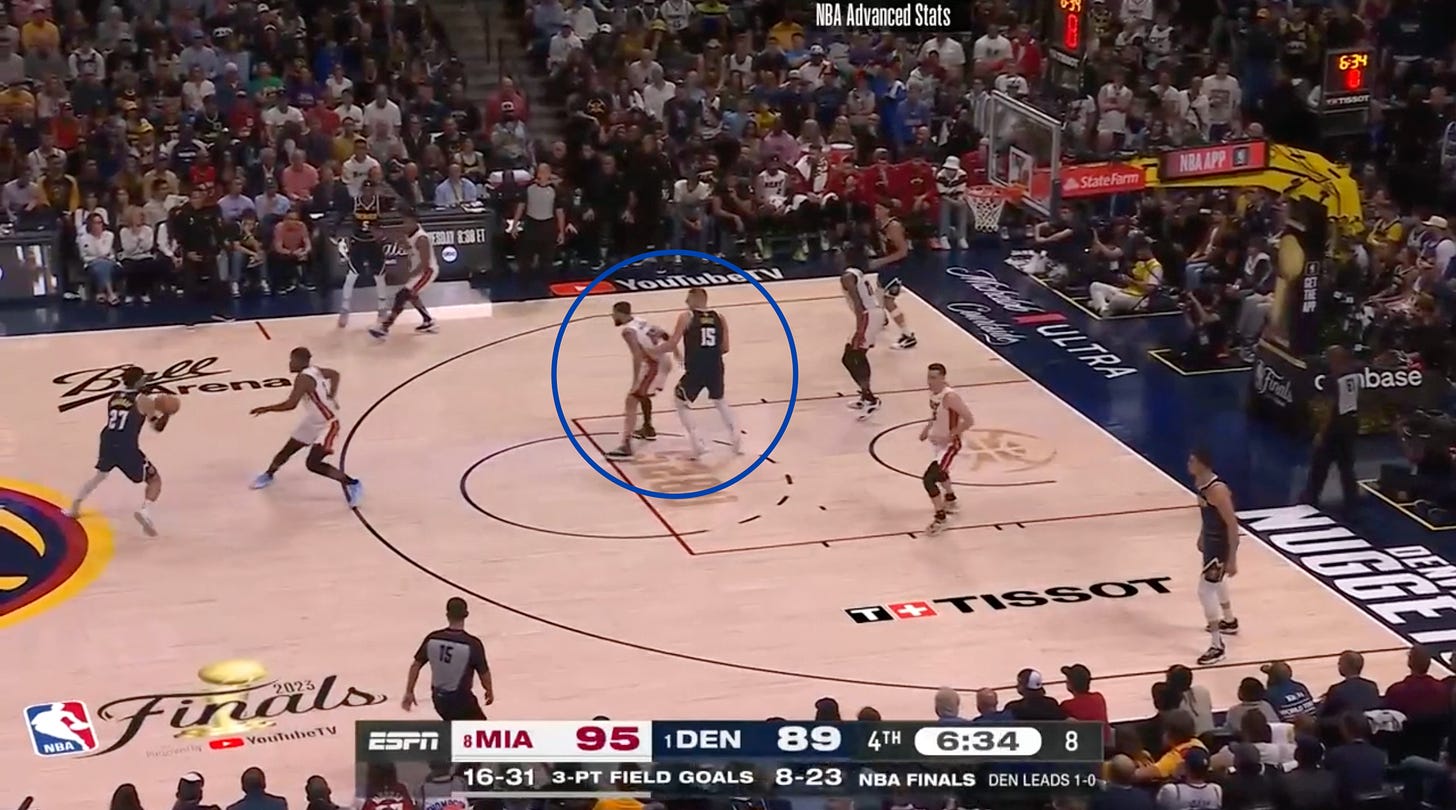How will the Heat approach Game 3 on defense?
Miami stole Game 2 on the road. Did they learn anything important, or will the Nuggets bounce back?
The Denver Nuggets hadn’t lost at home since a March regular season game before Sunday night, when the Miami Heat grabbed Game 2 to even the Finals at 1-1. The Heat used a fourth quarter outburst of three-pointers and zone defense to take the lead, which held up only barely at the buzzer.
Here’s what I’ll be watching in Game 3, with a focus on the Heat’s defense.
Did Miami really make Jokic into a scorer?
The discourse after Game 2 has focused on Miami purportedly forcing Nikola Jokic to be a scorer, rather than a passer. Jokic had 14 assists in the Game 1, but only four in the Game 2 loss.
Of course, Jokic had 41 points in Game 2 and the Nuggets had a blistering 124 offensive rating. The offense wasn’t the reason they lost.
But there is something to be said for Miami making things difficult for the Nuggets, especially in the second half. Denver’s offense has been borderline unstoppable in these playoffs.
Two (interconnected) adjustments helped the Heat. They started Kevin Love over Caleb Martin to put more size on the floor and prevent Aaron Gordon’s bully-ball that caused problems in Game 1. The knock-on effect of that decision: Jimmy Butler was free to guard Jamal Murray. Butler is the Heat’s best option on Murray.
Miami rarely sent aggressive help at Jokic. They forced him to score, and he did, but they also worked to deny the Nuggets’ dribble hand-off game, which is built on his passing. The improved pursuit and physicality of the Heat’s perimeter defenders (especially with Butler on Murray) took away the free cuts and open threes, taking Denver’s role players out of rhythm and limiting the offense’s options.
The ideal Heat defensive possession is something like this:
Butler, guarding Kentavious Caldwell-Pope on this play, forces Murray to make a pass, and Love reads the play. The key to these Murray-Jokic pick-and-rolls is Bam Adebayo preventing Jokic from receiving easy passes, and the way to do that is diligent, timely off-ball help.
The easy Nuggets counter here is being more intentional about spacing. If Jokic didn’t direct Murray toward the side of the court with two extra Heat defenders, they might’ve had more room to operate.
The Heat zone
There has been good coverage of the Heat zone elsewhere, so I won’t dive too deep into it, but this Erik Spoelstra creation is really something to behold. It helped win Game 2, even against this Denver offense, which is the ultimate zone-buster.
The crux of this zone: it’s a 2-3, except with some variations. The two guys at the top sometimes stack on top of each other, providing support on the ball and, crucially, taking away the guy flashing to the middle — which is the traditional way of beating a 2-3 zone.
Take this example:
Jokic tries to be the guy flashing to the middle. So whoever is the second guy in the stack, no matter his size, battles with him and denies him the ball. Adebayo always lurks at the rim.
The change from the normal 2-3 zone is that in the above scenario, Adebayo would step up to Jokic. It would be easy for Jokic, the passing master, to find a guy at the rim once he pulled Adebayo away. The Heat avoid that with the stack.
The other key difference involves the two guys in the corners. They’re always the weaker defenders, hiding from superstars, but they play an important role.
They tend to step forward, adding help to prevent penetration, no matter whether there’s a shooter in the corner:
Duncan Robinson is circled here. He will stunt at Murray, then recover to Bruce Brown in that corner, all while angling his body to prevent Murray from easily hitting Brown for a three. Robinson is an exploitable defender in man-to-man, but excels in this specific role.
This look, with the guys in the corners stepping up, shrinks the court and redirects offenses toward what the Heat want. Miami would rather you take a contested three than get into the paint.
Denver still has scored fairly well against the zone, because they are have an incredible offense. I see three ways that the Nuggets score against the zone:
Beating a guy off the dribble at the top of the key — which is an individual question, rather than a schematic one, but still a profitable form of offense.
Jokic catching the ball in the paint, often by screening the smaller guy battling him in the paint. Denver could send a screen for Murray with someone other than Jokic, then use that penetration to hit Jokic for a floater.
Early passes to wing shooters, preferably elite ones (Murray or Michael Porter Jr., namely). Those guys make contested threes consistently, and those shots will be there against that stack at the top.
Miami can’t run zone the whole game. No one in the NBA can. But it is absolutely a weapon.
Overall, the Heat don’t have any magic solutions after Game 2, or even all that much of a blueprint. They need the threes to keep falling, and for Butler to erupt at some point. We’ll see how Game 3 goes.






